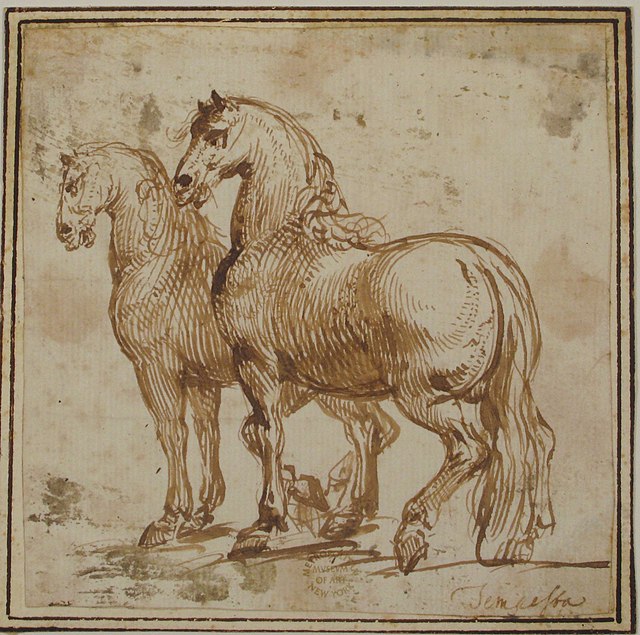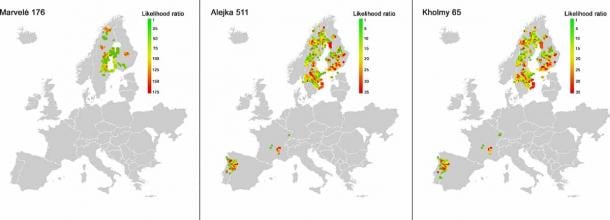A new study published this past weekend in the journal Science Advances finds that horse offerings were so important and popular in Baltic paganism from the 1st to 13th centuries CE that Baltic communities towards the end of this era sought a constant supply, even importing horses from Christians in Scandinavia.
Lead study author Katherine M. French, PhD, from the School of History, Archaeology, and Religion at Cardiff University, said in an interview with Archaeology Magazine, “This research dismantles previous theories that locally-procured stallions were exclusively selected for sacrifice. Given the unexpected prevalence of mares, we believe the prestige of the animal, coming from afar, was a more important factor in why they were chosen for this rite.”

Two Horses by Francesco Allegrini da Gubbio (Pen and brown ink). Metropolitan Museum of Art – Public Domain Dedication
Horse offerings likely waned due to the spread of Christianity in the Baltic region, particularly with the conversion of prominent leaders such as Mindaugas of Lithuania in 1251 CE. Before that, however, horses played a significant role in funerary rituals across Europe from prehistoric times to the medieval period. The socio-economic and prestige value of horses appeared to be significant. The authors write, “The public sacrifice and deposition of horses in human cemeteries are indelible features of Baltic archaeology from the 1st to 13th centuries CE and attest to the persistence of pagan belief systems.” Archaeological discoveries frequently reveal horse remains at burial sites.
One persistent issue with horse offerings is their inconsistency. “Offering pits” might contain parts of a horse, an entire horse, or even multiple horses. The arrangement varies widely: some horses are crouched, some laid out, and others appear dismembered. In some cases, the horses may have been buried alive. Horses were sometimes buried alongside humans, and other times separately. Both horses and humans might be cremated or not. Riding equipment was occasionally included, and there is evidence of intricate ritual interments. Despite the variations in method, which spanned over a thousand years, the consistent element is the significance of the horse as an offering.
Whatever the ritual, some aspects appeared highly consistent. The horses offered were almost exclusively male, at least so previous research suggested. The reason is not known but may be linked to the association of horses with a masculine, warrior culture, as suggested by some surviving contemporary texts. Alternatively, it could be due to the practical value of breeding mares in these populations.
The international team of researchers led by French conducted a detailed analysis of over 70 horse teeth from nine burial sites located in modern-day Poland, Lithuania, and the Russian exclave of Kaliningrad, dating from the 1st to the 13th centuries. They employed strontium isotope analysis, a technique that can trace the geographic origins of animal remains. This analysis revealed that some horses originated from regions as distant as modern Sweden or Finland, indicating that they had traversed the Baltic Sea and covered distances ranging from about 300 to 1,500 kilometers (roughly 200 to 1,000 miles). The authors wrote, “Although eastern Sweden and central Finland are the most likely candidates for the origin of the horses, we considered whether horses may have been brought to the region by the Germanic crusading orders.” They found that “There is no possibility that [the sample] originated anywhere in modern Germany, but there is a possibility that [some samples] could have originated in southern Germany.”
“Pagan Baltic tribes were clearly sourcing horses overseas from their Christian neighbors while simultaneously resisting conversion to their religion. This revised understanding of horse sacrifice highlights the dynamic, complex relationship between pagan and Christian communities at that time,” said Richard Madgwick, PhD, also from Cardiff University’s School of History, Archaeology, and Religion and a co-author of the study.

Analysis of these horse burials revealed that the medieval Balts obtained horses from Scandinavia and their value may have been a factor in their selection as an offering [via Science Advances]
Earlier research indicated that horses found in cemeteries were all male, typically identified by the presence of canine teeth. However, these findings are challenged by the current research. Previous assumptions in Baltic archaeology suggested that stallions were exclusively chosen for public rituals as offerings, believed to occur at the funerals of elite male warriors. The authors noted that their research cannot determine whether the males were stallions or geldings.
However, the genetic analyses in this study reveal a more nuanced picture: 66% of the horses were identified as stallions, while 34% were mares. Their findings suggest that male horses were not offered exclusively, meaning that other archaeological sites where mares were found were not outliers.
The researchers also noted that a “recent study of horse sacrifices in Iceland found that male horses were overwhelmingly chosen for sacrificial offerings, interpreted as evidence that the purpose of the ritual performance was to represent characteristics assigned to the stallion, namely, aggressiveness or virility.” But, this does not appear to be the case with the Balts. The sex imbalance in horse offerings observed in their findings “could be due to the relative economic importance of mares to the elite Balts who bred horses and consumed fermented horse milk.” The authors noted their research will continue. Meanwhile, the current findings highlight the nuances of trading relationships prospering despite the progressive Christianization of the region.
The Wild Hunt is not responsible for links to external content.
To join a conversation on this post:
Visit our The Wild Hunt subreddit! Point your favorite browser to https://www.reddit.com/r/The_Wild_Hunt_News/, then click “JOIN”. Make sure to click the bell, too, to be notified of new articles posted to our subreddit.